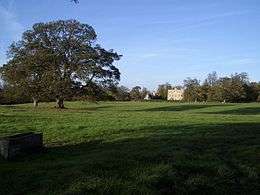Hinwick House
| Hinwick House | |
|---|---|
 | |
| General information | |
| Type | Manor house |
| Location | Hinwick, Bedfordshire |
| Country | England |
| Coordinates | 52°14′53″N 0°37′52″E / 52.248°N 0.631°E |
| Construction started | 1706 |
| Completed | 1710 |
| Renovated | 1992 & 2015 |
| Owner | The SINGH Family |
| Landlord | Owner |
| Technical details | |
| Floor count | 3 |
Listed Building – Grade I | |

Hinwick House is a grand Grade I listed Queen Anne country house near Podington, north Bedfordshire, modeled on the original Buckingham Palace, Buckingham House and set in 36 acres of magnificent parkland .[1] The estate consists of the Queen Anne Main House, The Victorian Wing, The Victorian Wing Extension, Garage Block, Stables, 3 cottages, a clock tower, a walled garden and a period dovecote
It was built in 1709-10 for Richard Orlebar, first occupied in 1714, stands to the north of the hamlet of Hinwick, Bedfordshire, England. The house stands in its own park of about 36 acres (150,000 m2) on the west side of the road from Podington and to the south of the Wollaston Road from which the house is approached along a drive. At the end of which are wrought-iron gates with stone piers surmounted by collared eagles' heads with wings displayed, the crest of the Orlebar family by whom the house was built.[2]
In the 1880s, the house became a school and during World War 1 was used as an auxiliary hospital for convalescing wounded soldiers.[3]
As of 2016, Hinwick House is for sale, with an asking price of £14.5M. [4]
Architecture
The house has three storeys, with the entrance front facing the east. At the back is a smaller house known as the Turret. This is the oldest block in the group of buildings, and probably dates from the 17th century. It was a low, T-shaped building, two storeys high, with dormers in the roof. It is built of stone and roofed with Collyweston stone slate, but at the time of the erection of the main house a small square addition surmounted by an hexagonal turret was made on the east side. On the east front the tower is open to the height of the floor of the top storey, and inside it is curved in plan with a double staircase leading up out of the garden to the first floor.
The larger house is three storeys high with a flat roof. In the centre of the east front, entered directly from the garden, is the hall, elaborately panelled, behind which is the inner hall. Out of the inner hall rises the staircase, a fine piece of 18th century joinery work, with delicately turned balusters and moulded hand-rail. On the north is the dining-room and on the south is the drawing-room. Several of the bedrooms are panelled. The entrance or east front is divided into three bays by four Corinthian pilasters, over which the cornice breaks, while from the cornice are carried up to the top of the balustrade, immediately over these pilasters, smaller ones of the Doric order. The level of the first floor is masked by a projecting string. At the sides of the entrance doorway are panelled pilasters with carved brackets supporting a cornice, above which is a cartouche carved with the arms of Orlebar impaling Astrey set within a broken pediment.
At the west angle of the south front is a Corinthian pilaster corresponding to the south angle pilaster to the front façade, while above the cornices is a triangular pediment, the tympanum of which is carved with a scene representing Diana hunting by John Hunt of Northampton who has also been credited with the design of the house but not proven. The interest of the west front is enhanced by the projecting wings on the north and south. The Victorian north wing of the house was built in 1859-66 by F. C Penrose in the Georgian style.
References
- ↑ "Hinwick House, Podington". British Listed Buildings.
- ↑ William Page (editor) (1912). "Parishes: Podington and Hinwick". A History of the County of Bedford: Volume 3. Institute of Historical Research.
- ↑ "Hinwick House" (PDF).
- ↑ "Hinwick, Wellingborough". Primelocation.com.
- Parishes: Podington and Hinwick, A History of the County of Bedford. Vol. 3. 1912. pp. 80–87.
- Pevsner, Nikolaus (1968). The Buildings of England, Bedfordshire, Huntingdon and Peterborough. London: Penguin Books.
See also
Coordinates: 52°14′53″N 0°37′52″W / 52.248°N 0.631°W